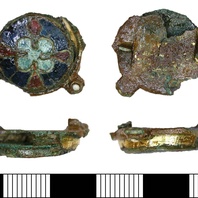
Viking Objects
Enamel Copper-Alloy Brooch (DENO-6C0D22)
This composite cast copper-alloy and enamel gilded brooch displays both Anglo-Scandinavian and Anglo-Saxon characteristics. The decorative enamel centre of the brooch was fabricated using a method known as cloisonné which involves the use of inlaid enamel cells, separated by strips of copper alloy, within an outer ring of copper alloy, all set upon a flat circular disc of copper alloy. The sides of the decorative roundel are surrounded with an upright strip of gilded copper alloy. The design of the enamel centre features a blue-green central quatrefoil, four cells which are shaped like elongated teardrops filled with red enamel giving the appearance of a cross motif, and four larger sub-rectangular cells filled with deep blue enamel. The brooch has been classified as Weetch Type 20. For more information on Scandinavian jewellery in England check out our blog: Brooches, Pendants and Pins: Scandinavian Dress Accessories in England.
Read More
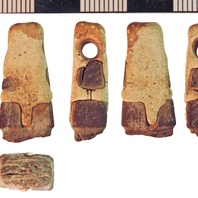
Viking Objects
Whetstone (NLM-7FA566)
Whetstone fragment, possibly made of slate that looks like ‘phyllite’, where the the broken end of the hone has been sheathed in lead, which has held its parts together. This is an unusual example of the repair of a personal hone so it could be continued to be carried and used after its breakage. The hone would originally have been of a tapered bar-shaped form and was sawn to shape. Hones of this size were personal items to be carried and worn at the belt alongside the knife they sharpened. True ‘phyllite’ hones came from Telemark in Norway, and were among the first imported whetstones of the Viking Age. A range of other banded and coloured stones, many found in graves at Birka, were adapted for similar use, and their fine appearance was as important as their usefulness as sharpening stones.
Read More
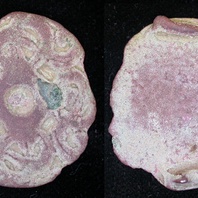
Viking Objects
Disc Brooch (LEIC-604DE5)
This example of an Anglo-Scandinavian copper-alloy disc brooch features a Borre-style knot design surrounded by a concave-sided lozenge motif. It has been classified as East Anglian Series Type I. For more information on Scandinavian jewellery in England check out our blog: Brooches, Pendants and Pins: Scandinavian Dress Accessories in England.
Read More
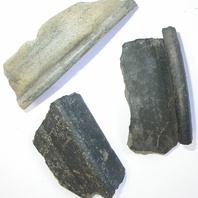
Viking Objects
Early Medieval Pottery Fragments (2001-59)
These are fragments of a Torksey ware rim, decorated Stamford ware rim, and a Stamford ware pot rim. Torksey ware was a type of pottery found in central England and dating to the period ad 850 to 1150. It was manufactured, initially by immigrant potters from Continental Europe, using a fast wheel at workshops around Torksey, Lincolnshire. While not having the same wide geographic distribution as Stamford ware, the popularity of Torksey ware in York was so high that it was initially thought that York was the original location of manufacture. Stamford ware is one of the earliest forms of lead-glazed ceramics in England, being produced in Stamford, Lincolnshire, between the ninth and thirteenth centuries and widely traded across Britain and the near continent. Early Stamford glazes were lead glazes, suggested by some to be unique among early English glazes since they contain traces of silver but not tin. The glaze could be of a pale yellow, orange, pale green, or smoke blue colour and was applied by using a brush.
Read More

Viking Names
Keythorpe
Keythorpe, in the Gartree Hundred of Leicestershire, is an Anglo-Scandinavian hybrid from the Old English male personal name Keyia or Keia and Old Norse þorp ‘a secondary settlement, a dependent outlying farmstead or hamlet’. It was a daughter settlement of Tugby, which it is now a joint parish with. Alternatively, the first element could be the Old English male personal name Cœga, but this seems to be too early of a name to pair with þorp. The Old English element cœg ‘a stone’ has also been suggested; however, the drift ecology does not reflect this postulation.
Read More
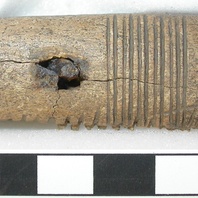
Viking Objects
Antler Comb (1986-976)
Fragments of an antler comb found on the site of Little Chester Roman fort (Derventio Coritanorum) in Derby. This comb is of Anglo-Scandinavian type. It consists of a flat plate of antler sandwiched between two strips of antler that are rounded on the exterior part. The whole is fixed together with an iron rivet. Nicks on the centre plate show that the teeth of the comb were cut after the three plates had been constructed and fixed.
Read More
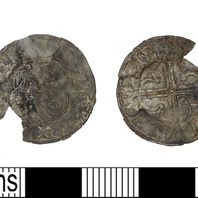
Viking Objects
Coin of Cnut the Great (LEIC-B1F8EA)
This coin is an example of a Quatrefoil type silver penny of Cnut, minted in Stamford or Norwich by the moneyer Thurstan. Minting coins was a way of controlling the means of exchange within a kingdom and one which created a more easily administered standardized system of trade. Moreover, the coins themselves were often used as propaganda, portraying symbols and statements that gave off a desired message. The Vikings later used the minting of coins to legitimise their own rule.
Read More
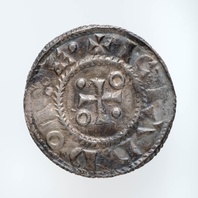
Viking Objects
Sihtric Caoch Silver Penny (CM.34-2000)
A sword and cross type silver penny of Sihtric Caoch (Sihtric Cáech) minted for the Viking kingdom of Northumbria. Sihtric Caoch was the Scandinavian ruler of Dublin from 917-920 CE and subsequently the ruler of Northumbria from 921-927 CE. It is not certain why he left Ireland. The Irish annals state that it was ‘through the grace of God’ and do not elaborate on the politics behind his departure. After the establishment of the Danelaw, some Viking leaders decided to mint their own coins to solidify their legitimacy in the eyes of the local populace. This created a hybrid economy where some members of the Danelaw used bullion and others used coins. This coin was part of a hoard of twelve coins found at Thurcaston between 1992 and 2000. The coins are Anglo-Saxon, Arabic and Viking issues, and show the diverse and wide-ranging contacts between societies at this time. The hoard was probably deposited c.923-925 CE, approximately five years after Leicester had been retaken by Mercia (c.918 CE). They indicate that a bullion economy was still operating in the Danelaw as late as the 920s. This suggests that the reconquest did not manage to institute Anglo-Saxon practices such as a monetary economy immediately.
Read More
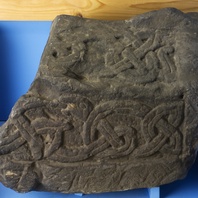
Viking Objects
St Alkmund’s Hogback Grave Marker (1996-60-5)
A stone hogback grave marker from St Alkmund’s Church, Derby. The site of St Alkmund’s Church is thought to have been on one of the oldest Christian sites in the area. Excavations on the site have shown that the church was in existence before the ninth century and that the presence of the Great Army in the ninth century seems to have led to a period of neglect and decay, before it was restored following the reconquest of the Danelaw in the tenth century or early eleventh century. Only about half of this hogback grave cover survives. It has the typical bear at the gable end, although the carving is damaged, and an interlaced serpent design within the panels on the side. It is typical of this type of grave cover which is found throughout northern England and into Scotland. They occur in Viking-dominated areas of the country, and appear to be an Anglo-Scandinavian tradition combining elements of pre-Christian and Christian iconography.
Read More
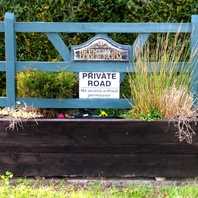
Viking Names
Brentingby
Brentingby, in the Framland Hundred of Leicestershire, is a difficult place-name that presents several problems. It is potentially an Anglo-Scandinavian hybrid from the Old English male personal name Branting or Brenting combined with Old Norse by ‘a farmland, a village’. Alternatively the name could be ‘the by of Brant’s people’ with the Old English –ingas ‘people of’ place-name forming element. However, an Old English folk-name combined with Old Norse by is unusual. Another suggestion is that an early Old English place-name Branting/Brenting, from Old English brant ‘steep’ and the place-name forming suffix –ing, was later compounded with Old Norse by thus ‘the farmstead, village at Branting (‘the steep place’)’. Brentingby stands on a steep slope above the flood-plain of the River Eye.
Read More
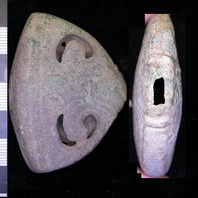
Viking Objects
Sword Pommel (LEIC-9158C3)
The pommel is probably a late development of Petersen’s type X which encompases transitional to medieval forms. Copper-alloy pommels with this basic shape are rare but not unknown in Viking Age Europe with a reasonably close example from Lough Derg, County Tipperary, in the National Museum of Ireland. The symmetrical Ringerike-style engraving is very similar to decoration commonly found on stirrup-strap mounts of the eleventh century.
